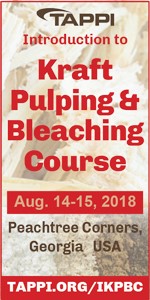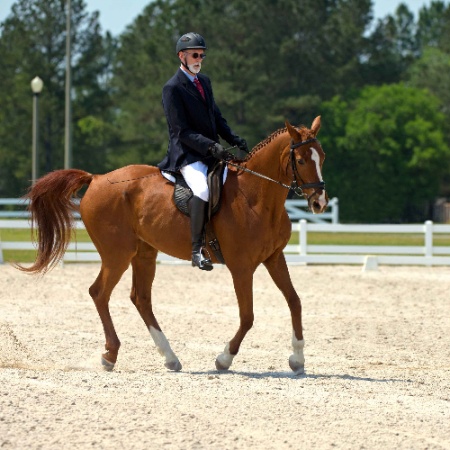| |
 · www.tappi.org
· www.tappi.org
· Subscribe
to Ahead of the Curve
· Newsletters
· Ahead
of the Curve archived issues
· Contact
the Editor

|
|
|
|
Vision Quest, Part 3: Serial Vision
S. ERIC CHRISTENSEN, Ed.D.
The problem with Vision is spelled out in my previous article, Vision Quest, Part 1: What You Get is Rarely What You Need. I wrote, "Most Visions (are) nothing more than a meaningless poster on the wall!" Until the problem is recognized, identified, and owned, nothing ever changes.
We discussed the first key element required to address this problem in Vision Quest, Part 2: How to get What You Really Need, which stated, "The first foundational principle that supports all effective and robust Visions is 'Reality Trumps Fantasy.'" Fixing the problem begins with having a clear understanding of reality. It is difficult to make happen, but it is not rocket science!

The author, working toward achieving his equestrian Vision.
Ending the End-State Obsession
Whether by chance or intent, Visioning efforts not only look at what the end state goal ought to be—they obsess about it! This obsession results in an absolute, permanent and unchanging Vision/Vision Statements. Everyone will say the statement is dynamic, but in real life it is static. In the leaders' minds, the visioning effort leads to the thought, "now we have it, we know where are going." Unfortunately, such a belief is a terrible misread.
People do not behave, think, live or work in this kind of a mindset. Hit the pause button for a second to reflect: Can YOU keep in mind what the organizational world is supposed to be in five years? Can YOU keep in mind what this means for you or your team or your direct reports or your supervisor? Most of us are fortunate if we can remember, in an applied sense, what our yearly goals are.
I know I cannot stay connected to the end-state, "poster on the wall" fantasy. I know that it is not just a stretch goal, but that (unfortunately) it is an all too often impossible and implausible goal! Perhaps the inhabitants of the Executive suite can stay plugged in, but rarely can anyone else. But wait a second—what is the purpose of a Vision? It is to grab the attention of the people who are making it happen, on the shop floor—day-to-day and 24/7.
This is not a criticism of executives or leadership; but Vision is intended to be aspirational and create hope in the workforce. How can that happen if attaining the Vision is just not possible?
There are visionaries who can spend their days in big picture abstractions. Such individuals are out there. As a matter of fact, this is a core trait of a transformational leader. However, transformational leaders are basically mythical creatures; you are more likely to be struck by lightning than you are to find and work with a truly transformational leader. Their ability to create, drive, and achieve "big picture" pictures is very rare.
This problem, however, can be fixed, even without a mythical transformational leader. Visioning needs to be looked at as an iterative process. First, identify the stretch goals that will drive the organization to make major and significant leaps toward the future state. These are achievable leaps, even those that sometimes require ineffable leaps of logic. Then sequence these Visions. Serial Vision creates a chain of unbreakable and attainable links. Serial Vision will take you to the future state that is not just a poster on the wall.
Leveling Up
I reflect again on my equestrian passion to explain. My personal riding Vision is to compete and be competitive in dressage. There are 10 levels of dressage tests: three in Introductory, three in Intermediate, and four in FEI (Federation Equestrian International). Simply getting your horse to move gracefully in a circle is very difficult; what FEI-level riders do is amazingly difficult. I passionately want to become good enough to compete in the Intermediate levels. Even this is perhaps unattainable in the years that I have left to ride. It is a stretch dream, a "big-leap" Vision!
To aspire to compete at the highest FEI Level, Grand Prix, is just plain foolish and counterproductive. While it is a huge stretch goal to compete at the Intermediate level, it is drug-induced fantasy to compete at the higher FEI level. Making that my goal will get in the way, not get me there.
Recent news out of Tesla provide a current, real life example. The company set a goal—a Vision—of 5,000 units per week. It has not been reached (not even close.) Neal E. Boudette, in an April 16, 2018 New York Times article, states:
"In production of the Model 3, Mr. Musk gambled by creating an assembly line that relies much more heavily on automated equipment and robots than workers. But it has proved more difficult than he expected to get the machinery to work in harmony… he has described the delays and glitches as 'production hell.'
"In a tweet over the weekend, Mr. Musk acknowledged that 'excessive automation at Tesla was a mistake. To be precise, my mistake. Humans are underrated.'"
Attainable, Achievable Process
A Vision of an automated plant where the product is rarely touched by human hands is a meaningless poster on the wall. Now the Tesla workforce is paying the price. I bet you big money at long odds that the workforce knew this was an unattainable, foolish, and perhaps reckless Vision. Not that it can never be achieved—but that it almost certainly cannot be achieved in the necessary time frame, with the available resources and current technology. Get ahead of yourself at your own peril.
In paper manufacturing there is a Vision of a world where no lift trucks and no humans will touch the paper once it comes off the reel until it is shipped out on rail or truck. As a dream this is interesting. As an attainable Vision for most mills it is off the chart crazy.
Most mills cannot get housekeeping right. The metrics are reviewed religiously. Housekeeping has a direct impact on safety, productivity, maintenance costs, mean time between failures, and basically everything that is important in a profitable facility. Yet keeping housekeeping at the Vision state is usually an elusive and never achieved state!
A shop floor where a new coat of light-colored paint stays clean for months is a major step. A floor where any oil leaks or metal shavings are instantly recognizable is a tremendous step forward. These examples might be links in a Paper Manufacturing Serial Vision process.
Thinking about Vision as a serial process forces attention towards the process. Vision is a series of short-term plans/accomplishments. Serial Vision requires that teams revisit frequently and effectively where they are and retool again and again to get to where they want to be.
An important hidden benefit is that the workforce will believe you have some smarts and "common sense." They will believe that you listened to them up front, which is highly unusual, and that you continue to value and listen to their ideas going forward. My goodness: this is employee engagement in practice, in real time, in the real world!
Vision is not "one and done." It requires an initial commitment of time and energy. Even more importantly, it requires a serial commitment of time and energy. Three to six months is the limit of Vision for most of us. At the end of this time cycle the process must refresh. It is not as difficult as the initial Vision setting, but it is perhaps even more important.
It is the course corrections along the way that will align the organization to an attainable, achievable and viable future. Serial Vision, Iterative Vision, Renewable Vision: it works, because that is how "we" work.
About the author:
S. Eric Christensen, Ed.D. has more than 35 years of experience designing and implementing sustainable work system/cultural change initiatives. As owner of Change That Works, LLC, and as an internal consultant with several large forest products companies, he has worked with industry clients on a variety of mill-based change initiatives. Reach him by e-mail at sec@changethatworks.solutions, or visit the website at www.changethatworks.solutions.
For a modest investment of $174, receive more than US$ 1000 in benefits in return.
Visit www.tappi.org/join for more details. |
|




